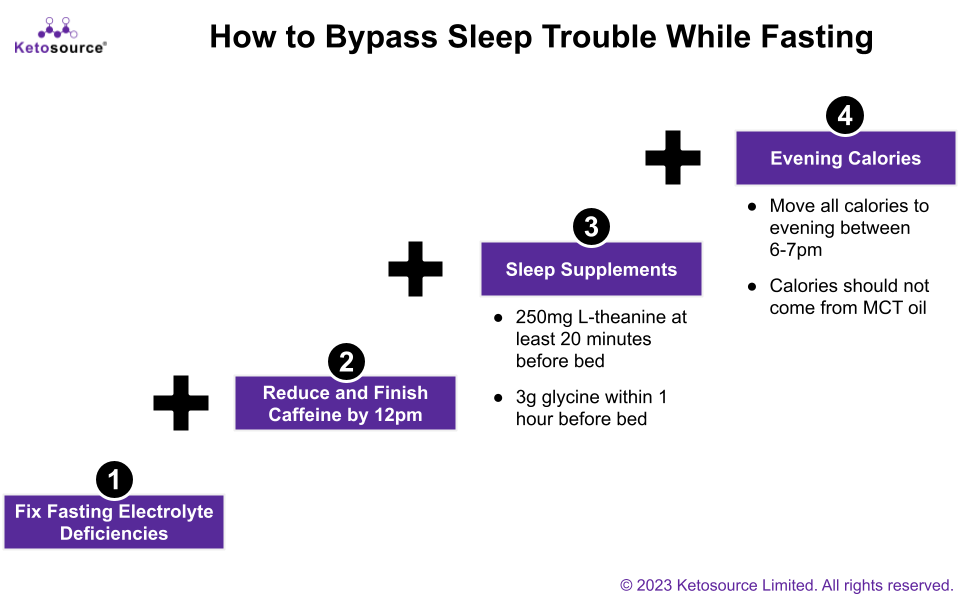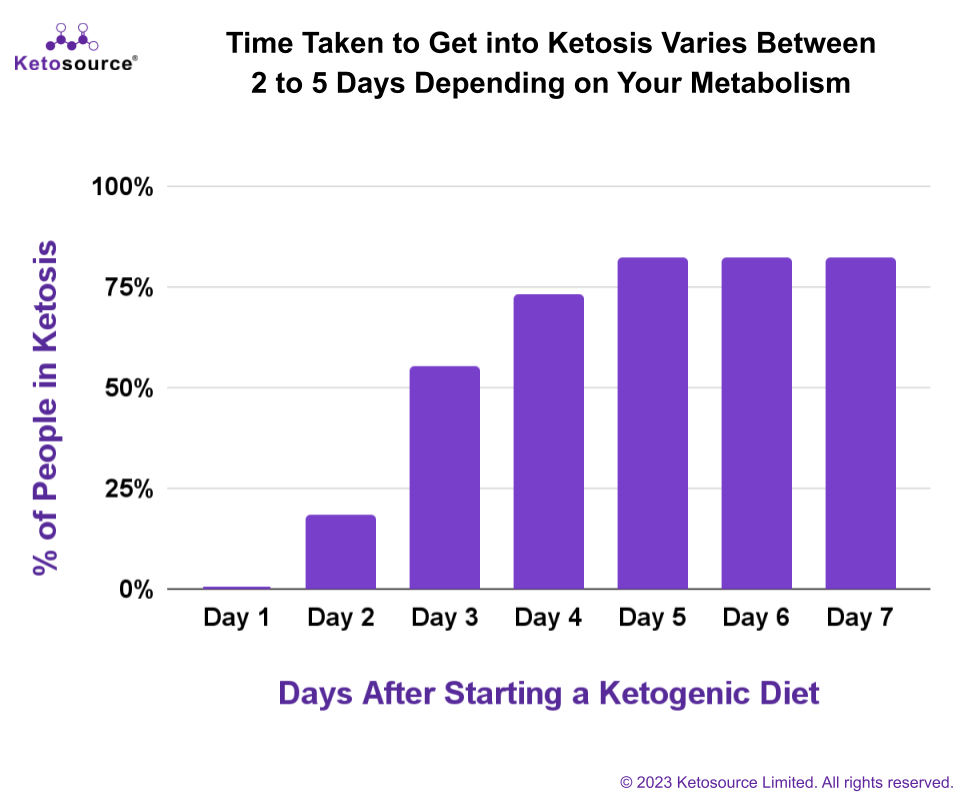ONE Actionable Takeaway from Ketosource
One of the top complaints we get about fasting is trouble with sleep. This is largely due to the promotion of sleep-disturbing hormones.
The most effective way to solve this is a four-step process.

Actionable Takeaways
Start with just the first step. You only need to take extra steps, one by one, should the problem persist. Most people won’t need to do all four.
- Electrolytes: Use our electrolyte calculator to solve deficiencies.
- Caffeine: Finish all caffeine intake by 12pm and reduce your daily intake if you still feel alert by bedtime.
- Sleep Supplements: Take l-theanine and glycine before bedtime as they help with sleep.
- Evening calories: Move all or some of the calories you eat on your fasting days to the evening between 6 and 7 pm (e.g. your one meal of the day). But don’t take MCT oil in the evening as it can promote sleep issues for some people.
ONE Quote from a Credible Expert
Adding extra fats to your keto diet can be counterproductive for health goals and fat loss goals in particular. It’s not a “free food” as you may read from some sources.
This quote comes from Andreas Eenfeldt, MD. Andreas is a medical doctor specializing in family medicine and the founder of Diet Doctor, a popular low-carb diet information source.
“What it comes down to when it comes to keto and low carb the most common mistake that i think people do… well it’s a mistake if you’re struggling with losing the weight that you want to lose or improving your metabolic health as much as you want to. I think for a lot of people it comes down to the amount of added fats.
If you’re adding a lot of bulletproof coffee, and oils to your foods, you’re eating high-fat dairy, and you’re eating lots of nuts which are you know high in fats. Then that may slow down your progress and possibly reducing that a bit… [you] might still be able to enjoy delicious foods. But you might also get better results.
So that’s I think one mistake people can do. Because if you think that fat is kind of free food. And you know it doesn’t raise your insulin so it doesn’t matter. Then that might be misleading and might be might be holding people back.”
Source: Diet Doctor — Past, present, and future with Dr. Andreas Eenfeldt — Diet Doctor Podcast,(timestamp 0:22:11)
ONE of Your #1 Questions Answered
The Question:
The top question sent in from you this week was from Enno F.. Thank you Enno!
“Why should one do cycling-in and a cycling-out [cyclic ketogenic diet] as proposed by some researchers in this field of ketogenesis?”
The Answer:
Definition of the Cyclic Ketogenic Diet: The most common model is where you eat carbs for one or two days per week (e.g. weekends), known as cycling-out. The rest of the week you follow the ketogenic diet (e.g. Monday to Friday). It’s known as the cyclic ketogenic diet, because you cycle in and out of ketosis.
There is limited research specifically on Cyclic Ketogenic Diets. So to answer this question we’ve used studies looking at the mechanisms involved with cycling in and out of a ketogenic diet.
From those studies, you could expect the following impact on ketosis:
- Cycling-Out: When you reintroduce carbs for one or two days (cycle-out) you are kicked out of appetite reduction ketosis within 30 minutes of reintroducing the carbs.
- Cycling-In: Depending on your metabolism, after you remove the carbs (cycle-in) it can take up to 4 or 5 days to get back into appetite-reducing ketosis.

Based on the data from this study, we could expect you to be in ketosis as follows given a Cyclic Ketogenic Diet with just 1 carb day on a Saturday:
- Best Case = 5 Days: If you have a top 20% metabolism you re-enter ketosis on day 2. This means you are out of ketosis your carb days + 1 day.
- Worst Case = 2 Days: If you have a bottom 25% metabolism you re-enter ketosis on day 5. This means you are out of ketosis your carb days + 4 days.
So what does this mean for fat loss goals?
Less appetite reduction ketosis days is likely to limit your progress towards fat loss goals. The extent to which this happens, will depend on your metabolism.
This is because:
- Appetite reduction ketosis is what allows you to eat less at your meals, reduce your calorie intake, and therefore, lose fat over time.
- When outside of ketosis you may experience higher hunger levels and overeat. This could lead to either no fat loss or fat gain.
Two Additional Downsides
There are two other points that make Cyclical Keto Diets less attractive:
- Downstream Negative Impacts of Blood Glucose Spikes: When on a ketogenic diet taking carbs can lead to larger blood glucose spikes. With a Cyclic Ketogenic Diet this may be happening every week. This raises a risk of vascular damage from carbohydrate consumption.
- Challenges with Fat Loss Tracking: When you come off the ketogenic diet you regain water weight. It then takes time for you to lose this again. The result on any fat loss metrics you track will be that they will cycle up and down on a weekly basis. This makes it harder to track true fat loss progress over time. This will impact both your weight and your WHtR (Waist-to-Height Ratio) tracking.
Actionable Takeaways
- Avoid the Cyclic Ketogenic Diet for Fat Loss Goals:
- Keep it simple. Use the ketogenic diet we recommend.
- Based on the evidence and our experience with clients it’s high certainty that you will experience worse results with a cyclic ketogenic diet.
- If You Still Want to Follow a Cyclic Ketogenic Diet: You can reduce the risk of negative results with two actions.
- 1) Track Blood Ketones and Glucose: Track ketones daily to confirm you are in appetite reduction ketosis a minimum of 5 days per week. Track glucose (via Continuous Glucose Monitor ideally) to check for high blood glucose spikes on your carb days.
- 2) Limit your carb intake to low glycemic carbs: Do this on your carb days to reduce the size of the blood glucose spikes.
- 3) Track Fat Loss Progress on Your Last Keto Day Only: To bypass the challenges with fat loss tracking only track on your last keto day each week with the WHtR. This will give you the most accurate reading on your progress.